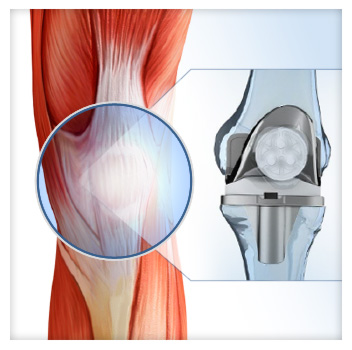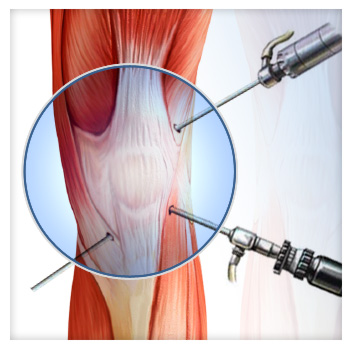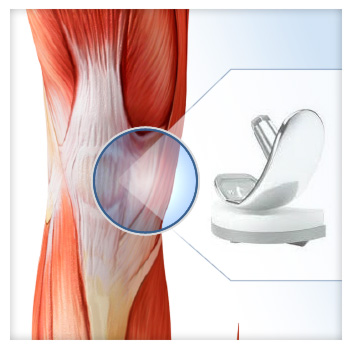Knee Surgery
Three Main Procedures
Partial Knee ReplacementUnlike total knee replacement involving the removal of all the knee joints surfaces, this one replaces only one side of the knee joint. The surgery is minimally invasive and allows the outer compartment and all ligaments to remain intact. Which means recovery is much easier. However, If you have a torn ACL, arthritis outside of the knee, rheumatoid arthritis or are overweighted, a total knee replacement will be a better solution. |

Total Knee ReplacementTotal knee replacement surgery is a procedure in which a painful or poorly functional knee is replaced with artificial components. Dr. Mead will recommend this surgery if your knee is highly damaged by arthritis or injury. Most total knee replacement take approximately 2 hours. |

Knee arthroscopyKnee arthroscopy is used in diagnosis and treatment of a number of knee disorders and injuries. One common use is in the treatment of meniscal tears. Injuries or arthritis can cause the meniscus to become torn, resulting in knee pain, swelling and diminish range of motion. Dr. Mead will perform a knee arthroscopy to remove the damaged portion of the knee. |
Minimally Invasive Total Knee Replacement
Total knee replacement (knee arthroplasty) is a surgery that is performed for severe degenerative disease of the knee joint. More than 300,000 people undergo the procedure each year.
Minimally invasive total knee replacement involves the use of a smaller incision than the one used in traditional knee replacement. In the traditional method, the incision averages 8 to 10 inches in length. In minimally invasive knee surgery, the incision is only 4 to 6 inches long. Because there is less damage to the tissue around the knee, patients who undergo this procedure may expect a shorter hospital stay, a shorter recovery, and a better looking scar.
Arthritis and Knee Replacement
Knee replacement is the resurfacing of the worn out surfaces of the knee and replacing the lost cartilage and diseased bone with metal and plastic. Knees wear out for a variety of reasons, including inflammation from arthritis, injury, or simple wear and tear.
Arthritis can run in families. Most knee arthritis is due to a lifetime of wear and tear. Nobody knows why some people get severe arthritis, while others don’t, or why arthritis can occur in one knee and not the other. Previous injury and obesity are some known causes of arthritis.
Symptoms
Knee arthritis leads to pain, which often happens with activity. The knee can also hurt at rest. Patients often find it difficult to climb or go down stairs, walk distances, or get up from low seats. Patients may also have swelling about the knee, stiffness, or a feeling of looseness.
Treatment Options
Nonsurgical Treatment
The first steps in treating knee arthritis are activity modification, regular exercise, and weight loss. The muscles around the knee protect it during activity. With every step, forces equal to several times a person’s body weight are transmitted through the knee. Therefore, improved strength and decreased body weight can prolong the life of the knee.
Soft knee braces and shoe modifications can sometimes help. Pain relievers and anti-inflammatory medications are also recommended. Some dietary supplements might also help. A cane or walker can also be tried to assist with walking and to improve mobility.
Steroid injections directly into the knee can be used to decrease inflammation. A lubricant may be used to improve the function of the knee. These can offer some relief. They can be repeated from time to time if they help.
Surgical Treatment
Knee replacement is recommended for knee arthritis if nonsurgical treatments have failed and the pain is limiting lifestyle and activities. Surgical options include knee arthroscopy (although this is rarely used just for arthritis), partial knee replacement, and total knee replacement.
The goal of knee replacement is to provide a pain-free knee that allows relatively normal activities and lasts for a long time. To achieve these goals, it is important that the knee implants be inserted with proper positioning. The bones and ligaments are prepared very carefully to allow the knee to be functional and durable. Using the current techniques, 90% to 95% of knee replacements last 15 years or longer.
Minimally Invasive Knee Replacement
Minimally invasive knee replacement accomplishes everything that a traditional knee replacement does, but through a smaller incision (4- to 6-inch incision compared with an 8- to 10-inch incision). With the smaller incision come the potential benefits of a shorter hospital stay, shorter recovery, and a better looking scar.
Although there is no question that an artificial knee can be implanted through a smaller incision, doctors still don’t know whether it can be done as well as with the traditional approach.
New techniques for opening the knee may be more important than the length of the incision. Some techniques are “quadriceps-sparing” because they protect the quadriceps tendon and muscle in the front of the thigh. Other techniques called “mid-vastus” and “sub-vastus” make small incisions in the muscle but are also less invasive.
Outcomes
Several early studies of minimally invasive knee replacement surgery have shown some benefits compared with traditional knee replacement, such as less blood loss, shorter hospital stay, and better motion. Other studies have shown a higher rate of complications with minimally invasive knee surgery, including poorer positioning of the knee implants.


